Comprehensive Educational Assessment and Recommendations Report
VerifiedAdded on 2022/08/08
|11
|3019
|48
Report
AI Summary
This report presents a comprehensive analysis of two research-based educational assessments: the Behavior Assessment System for Children, 2nd Edition (BASC-2) and the Gray Oral Reading Test-4 (GORT-4). The report begins with an introduction to systematic management methods in academic research and the pivotal role of assessments. It describes the BASC-2, a tool for evaluating behavior and self-perceptions in children and young adults, and the GORT-4, designed to assess oral reading skills. The report includes scale summaries for two students, Kaile and John, detailing their performance on the assessments. For Kaile, the BASC-2 results indicate clinically significant externalizing problems, hyperactivity, and aggression, with recommendations for intervention. John's GORT-4 results reveal difficulties in articulation and comprehension. The report concludes with recommendations for teachers to support the students' needs based on the assessment results, emphasizing strategies to address hyperactivity and reading comprehension challenges. The report also addresses the reliability and validity of the assessments, as well as the limitations of each tool.

0EDUCATIONAL ASSESSMENT FOR A DISABILITY
EDUCATIONAL ASSESSMENT FOR A DISABILITY
Name of the Student:
Name of the University:
Author Note:
EDUCATIONAL ASSESSMENT FOR A DISABILITY
Name of the Student:
Name of the University:
Author Note:
Paraphrase This Document
Need a fresh take? Get an instant paraphrase of this document with our AI Paraphraser
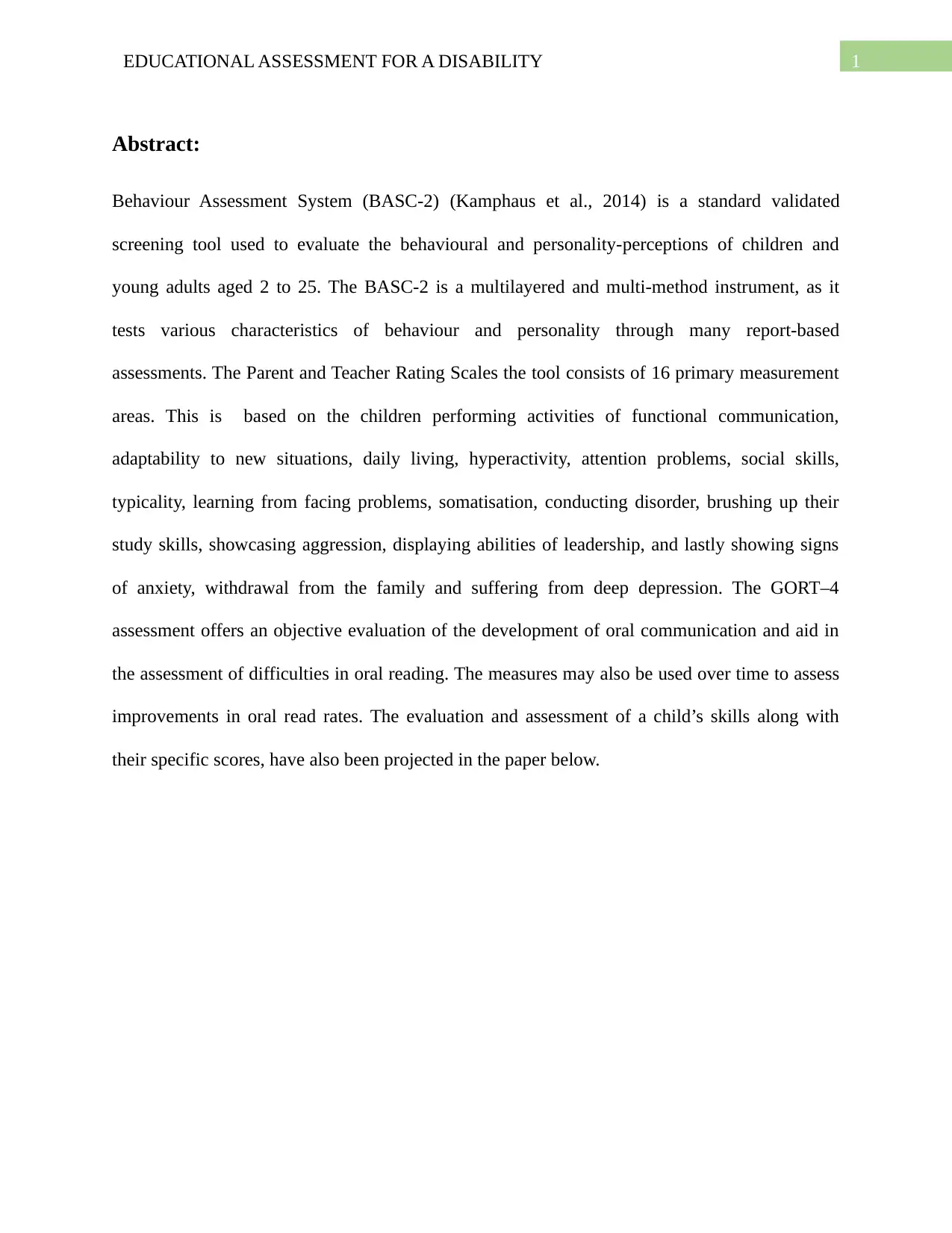
1EDUCATIONAL ASSESSMENT FOR A DISABILITY
Abstract:
Behaviour Assessment System (BASC‐2) (Kamphaus et al., 2014) is a standard validated
screening tool used to evaluate the behavioural and personality-perceptions of children and
young adults aged 2 to 25. The BASC‐2 is a multilayered and multi-method instrument, as it
tests various characteristics of behaviour and personality through many report-based
assessments. The Parent and Teacher Rating Scales the tool consists of 16 primary measurement
areas. This is based on the children performing activities of functional communication,
adaptability to new situations, daily living, hyperactivity, attention problems, social skills,
typicality, learning from facing problems, somatisation, conducting disorder, brushing up their
study skills, showcasing aggression, displaying abilities of leadership, and lastly showing signs
of anxiety, withdrawal from the family and suffering from deep depression. The GORT–4
assessment offers an objective evaluation of the development of oral communication and aid in
the assessment of difficulties in oral reading. The measures may also be used over time to assess
improvements in oral read rates. The evaluation and assessment of a child’s skills along with
their specific scores, have also been projected in the paper below.
Abstract:
Behaviour Assessment System (BASC‐2) (Kamphaus et al., 2014) is a standard validated
screening tool used to evaluate the behavioural and personality-perceptions of children and
young adults aged 2 to 25. The BASC‐2 is a multilayered and multi-method instrument, as it
tests various characteristics of behaviour and personality through many report-based
assessments. The Parent and Teacher Rating Scales the tool consists of 16 primary measurement
areas. This is based on the children performing activities of functional communication,
adaptability to new situations, daily living, hyperactivity, attention problems, social skills,
typicality, learning from facing problems, somatisation, conducting disorder, brushing up their
study skills, showcasing aggression, displaying abilities of leadership, and lastly showing signs
of anxiety, withdrawal from the family and suffering from deep depression. The GORT–4
assessment offers an objective evaluation of the development of oral communication and aid in
the assessment of difficulties in oral reading. The measures may also be used over time to assess
improvements in oral read rates. The evaluation and assessment of a child’s skills along with
their specific scores, have also been projected in the paper below.
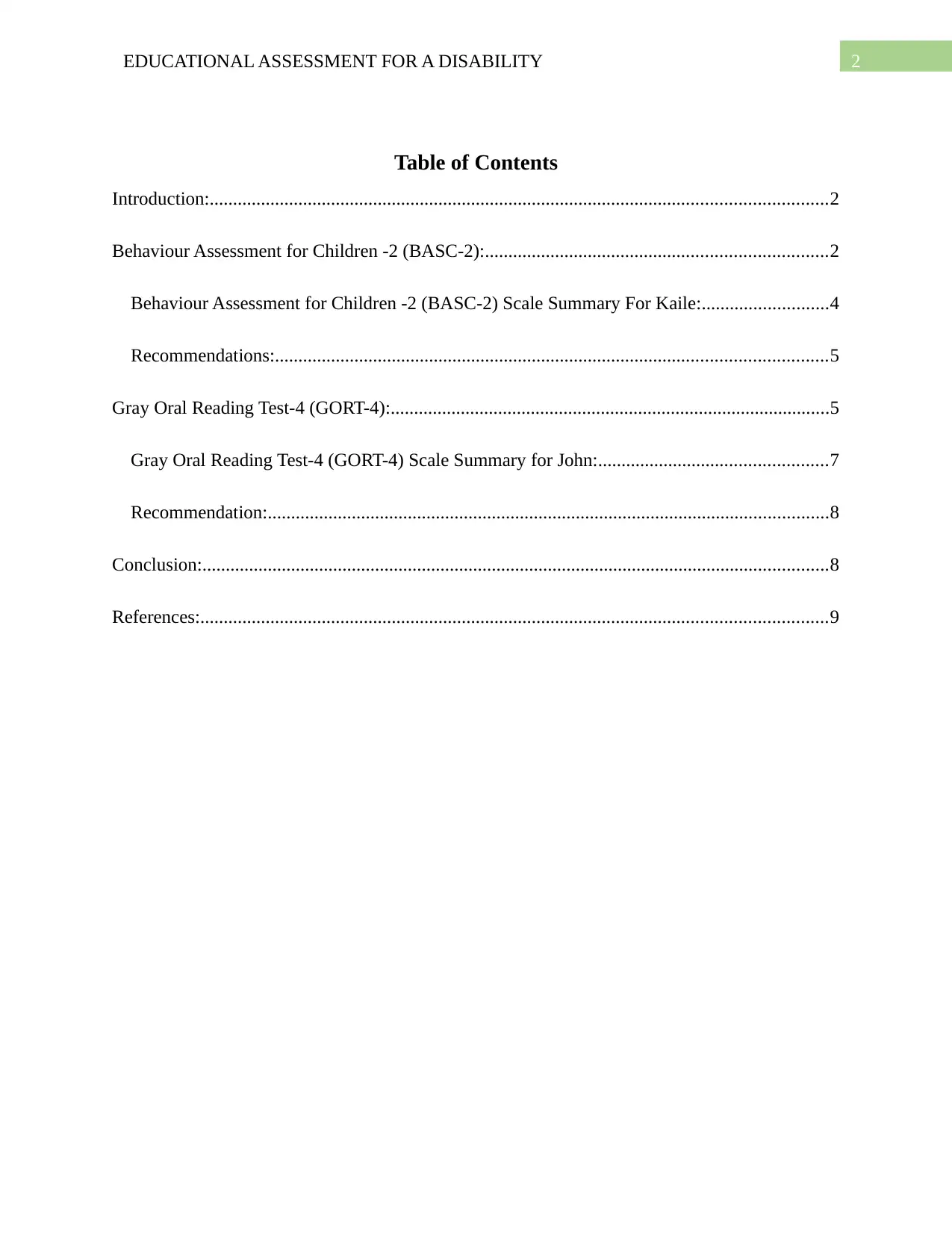
2EDUCATIONAL ASSESSMENT FOR A DISABILITY
Table of Contents
Introduction:....................................................................................................................................2
Behaviour Assessment for Children -2 (BASC-2):.........................................................................2
Behaviour Assessment for Children -2 (BASC-2) Scale Summary For Kaile:...........................4
Recommendations:......................................................................................................................5
Gray Oral Reading Test-4 (GORT-4):..............................................................................................5
Gray Oral Reading Test-4 (GORT-4) Scale Summary for John:.................................................7
Recommendation:........................................................................................................................8
Conclusion:......................................................................................................................................8
References:......................................................................................................................................9
Table of Contents
Introduction:....................................................................................................................................2
Behaviour Assessment for Children -2 (BASC-2):.........................................................................2
Behaviour Assessment for Children -2 (BASC-2) Scale Summary For Kaile:...........................4
Recommendations:......................................................................................................................5
Gray Oral Reading Test-4 (GORT-4):..............................................................................................5
Gray Oral Reading Test-4 (GORT-4) Scale Summary for John:.................................................7
Recommendation:........................................................................................................................8
Conclusion:......................................................................................................................................8
References:......................................................................................................................................9
⊘ This is a preview!⊘
Do you want full access?
Subscribe today to unlock all pages.

Trusted by 1+ million students worldwide

3EDUCATIONAL ASSESSMENT FOR A DISABILITY
Introduction:
Systematic management method are found to develop in order to perform or help in
conducting researches that are interdisciplinary in nature and are performed at the academic
research level. The assessment of the studies that are conducted by proposing as well as
introducing various performances that help in playing a pivotal role as indicators. They are found
at a certain degree of internal collaboration and have the capability to bring high research filled
productivity. The paper below discusses the two detailed research-based assessment. The
Behaviour Assessment System for the children 2nd edition (BASC-2) is regarded as one of the
diagnostic tools that are designed to assess and evaluate the behaviour and self-perceptions of the
children and the younger generation of the adults. The Gray oral reading test-4 (GORT-4) is
known to have a long and distinguished history of assessing the reading skills of a child. The
paper further provides the reasoning behind the test, explains the GORT-4, addresses how the
analysis is performed and graded and describes the psychometric properties of the test.
Moreover, the paper below also discusses the case study of two student named Kylie and John,
and focus on the student’s ability related to the assessments. The evaluation and assessment of
their skills along with their specific scores, have also been projected in the paper below. Lastly,
the paper recommends the teacher to help support the needs of the student based on the
assessment results.
Behaviour Assessment for Children -2 (BASC-2):
The Children's 2nd Edition Behaviour Assessment System (BASC‐2) (Kamphaus et al.,
2014) is a standard validated screening tool used to evaluate the personality-perceptions and
behavioural of children and young adults who are aged from 2 to 25. The BASC‐2 is a
Introduction:
Systematic management method are found to develop in order to perform or help in
conducting researches that are interdisciplinary in nature and are performed at the academic
research level. The assessment of the studies that are conducted by proposing as well as
introducing various performances that help in playing a pivotal role as indicators. They are found
at a certain degree of internal collaboration and have the capability to bring high research filled
productivity. The paper below discusses the two detailed research-based assessment. The
Behaviour Assessment System for the children 2nd edition (BASC-2) is regarded as one of the
diagnostic tools that are designed to assess and evaluate the behaviour and self-perceptions of the
children and the younger generation of the adults. The Gray oral reading test-4 (GORT-4) is
known to have a long and distinguished history of assessing the reading skills of a child. The
paper further provides the reasoning behind the test, explains the GORT-4, addresses how the
analysis is performed and graded and describes the psychometric properties of the test.
Moreover, the paper below also discusses the case study of two student named Kylie and John,
and focus on the student’s ability related to the assessments. The evaluation and assessment of
their skills along with their specific scores, have also been projected in the paper below. Lastly,
the paper recommends the teacher to help support the needs of the student based on the
assessment results.
Behaviour Assessment for Children -2 (BASC-2):
The Children's 2nd Edition Behaviour Assessment System (BASC‐2) (Kamphaus et al.,
2014) is a standard validated screening tool used to evaluate the personality-perceptions and
behavioural of children and young adults who are aged from 2 to 25. The BASC‐2 is a
Paraphrase This Document
Need a fresh take? Get an instant paraphrase of this document with our AI Paraphraser
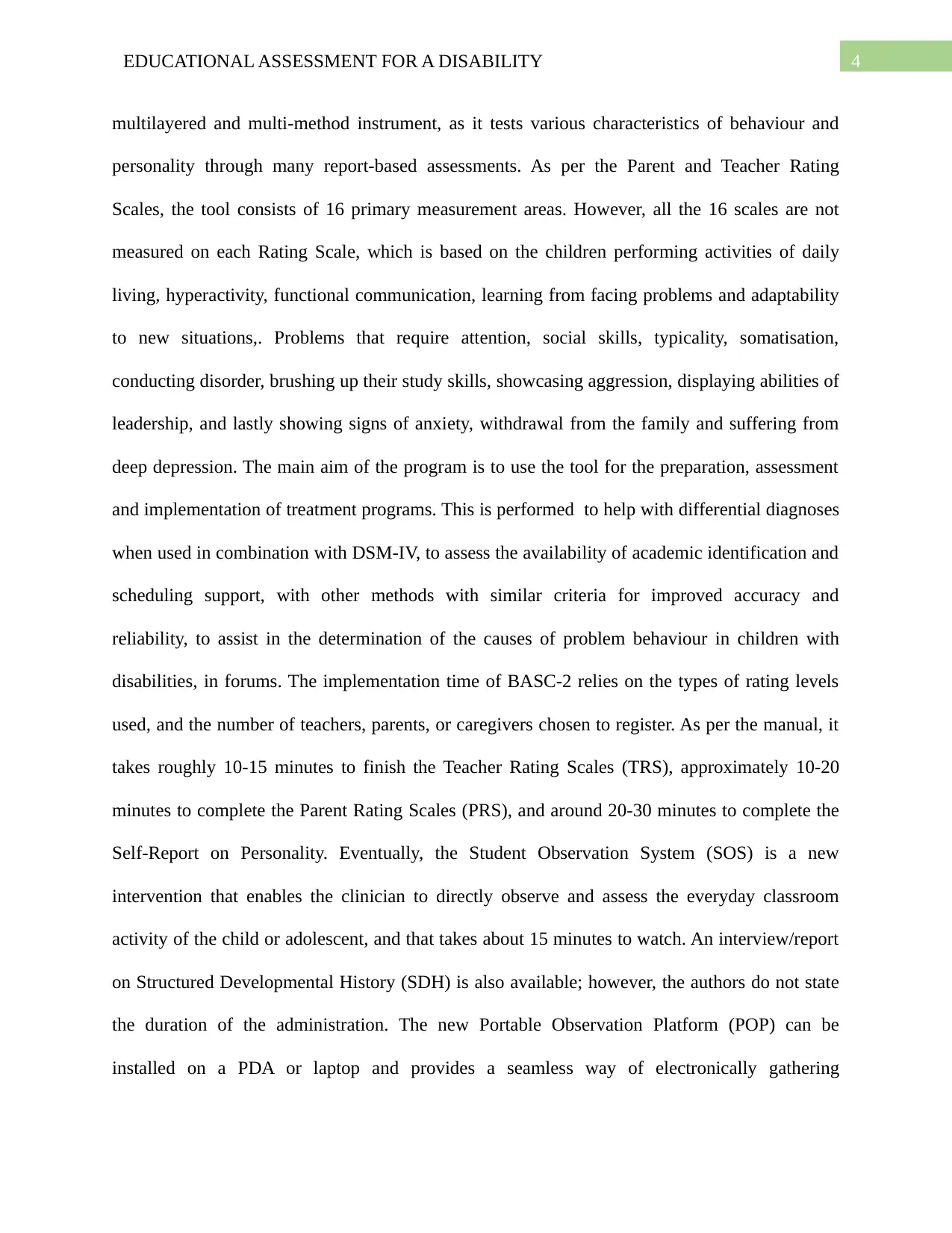
4EDUCATIONAL ASSESSMENT FOR A DISABILITY
multilayered and multi-method instrument, as it tests various characteristics of behaviour and
personality through many report-based assessments. As per the Parent and Teacher Rating
Scales, the tool consists of 16 primary measurement areas. However, all the 16 scales are not
measured on each Rating Scale, which is based on the children performing activities of daily
living, hyperactivity, functional communication, learning from facing problems and adaptability
to new situations,. Problems that require attention, social skills, typicality, somatisation,
conducting disorder, brushing up their study skills, showcasing aggression, displaying abilities of
leadership, and lastly showing signs of anxiety, withdrawal from the family and suffering from
deep depression. The main aim of the program is to use the tool for the preparation, assessment
and implementation of treatment programs. This is performed to help with differential diagnoses
when used in combination with DSM-IV, to assess the availability of academic identification and
scheduling support, with other methods with similar criteria for improved accuracy and
reliability, to assist in the determination of the causes of problem behaviour in children with
disabilities, in forums. The implementation time of BASC‐2 relies on the types of rating levels
used, and the number of teachers, parents, or caregivers chosen to register. As per the manual, it
takes roughly 10-15 minutes to finish the Teacher Rating Scales (TRS), approximately 10-20
minutes to complete the Parent Rating Scales (PRS), and around 20-30 minutes to complete the
Self-Report on Personality. Eventually, the Student Observation System (SOS) is a new
intervention that enables the clinician to directly observe and assess the everyday classroom
activity of the child or adolescent, and that takes about 15 minutes to watch. An interview/report
on Structured Developmental History (SDH) is also available; however, the authors do not state
the duration of the administration. The new Portable Observation Platform (POP) can be
installed on a PDA or laptop and provides a seamless way of electronically gathering
multilayered and multi-method instrument, as it tests various characteristics of behaviour and
personality through many report-based assessments. As per the Parent and Teacher Rating
Scales, the tool consists of 16 primary measurement areas. However, all the 16 scales are not
measured on each Rating Scale, which is based on the children performing activities of daily
living, hyperactivity, functional communication, learning from facing problems and adaptability
to new situations,. Problems that require attention, social skills, typicality, somatisation,
conducting disorder, brushing up their study skills, showcasing aggression, displaying abilities of
leadership, and lastly showing signs of anxiety, withdrawal from the family and suffering from
deep depression. The main aim of the program is to use the tool for the preparation, assessment
and implementation of treatment programs. This is performed to help with differential diagnoses
when used in combination with DSM-IV, to assess the availability of academic identification and
scheduling support, with other methods with similar criteria for improved accuracy and
reliability, to assist in the determination of the causes of problem behaviour in children with
disabilities, in forums. The implementation time of BASC‐2 relies on the types of rating levels
used, and the number of teachers, parents, or caregivers chosen to register. As per the manual, it
takes roughly 10-15 minutes to finish the Teacher Rating Scales (TRS), approximately 10-20
minutes to complete the Parent Rating Scales (PRS), and around 20-30 minutes to complete the
Self-Report on Personality. Eventually, the Student Observation System (SOS) is a new
intervention that enables the clinician to directly observe and assess the everyday classroom
activity of the child or adolescent, and that takes about 15 minutes to watch. An interview/report
on Structured Developmental History (SDH) is also available; however, the authors do not state
the duration of the administration. The new Portable Observation Platform (POP) can be
installed on a PDA or laptop and provides a seamless way of electronically gathering
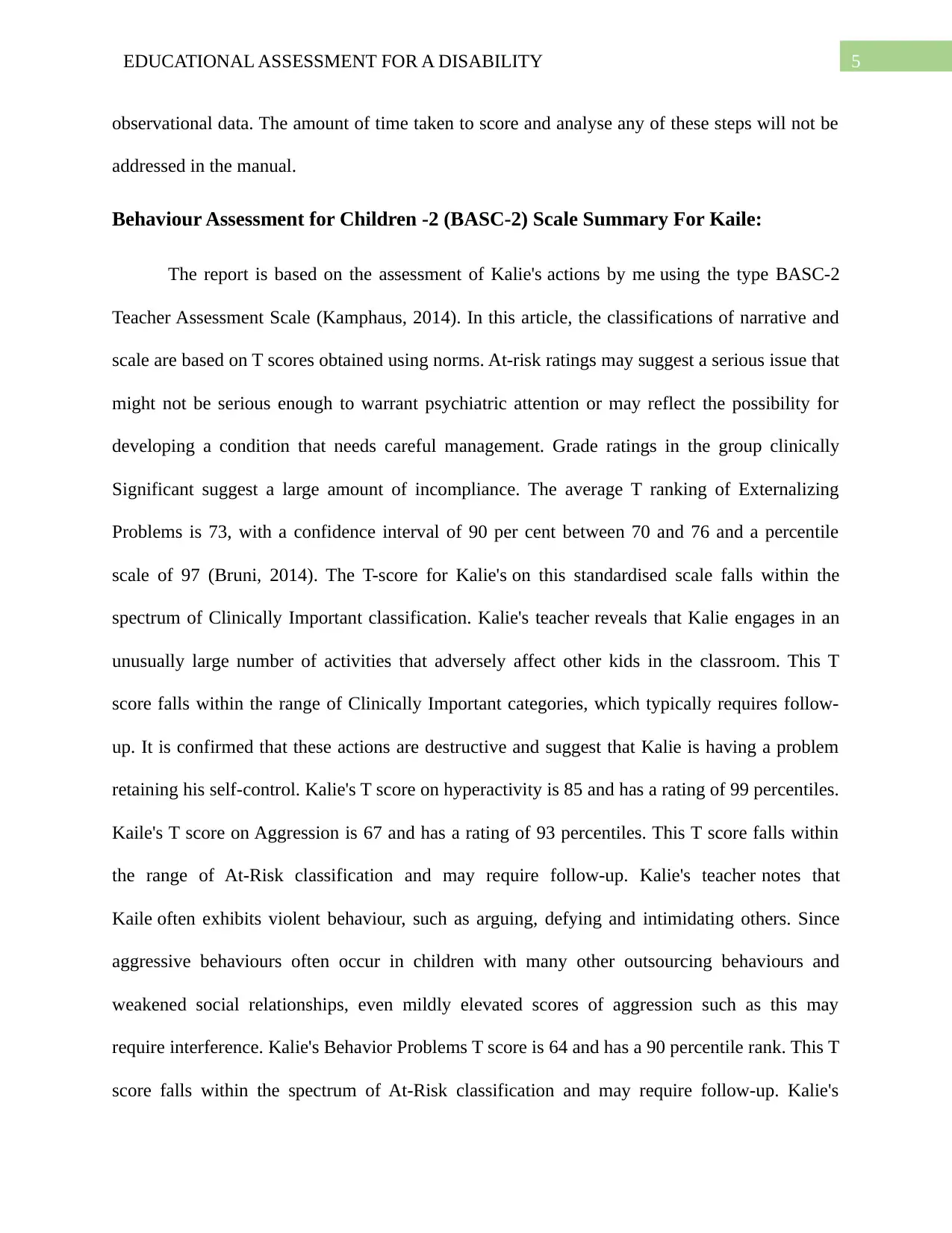
5EDUCATIONAL ASSESSMENT FOR A DISABILITY
observational data. The amount of time taken to score and analyse any of these steps will not be
addressed in the manual.
Behaviour Assessment for Children -2 (BASC-2) Scale Summary For Kaile:
The report is based on the assessment of Kalie's actions by me using the type BASC-2
Teacher Assessment Scale (Kamphaus, 2014). In this article, the classifications of narrative and
scale are based on T scores obtained using norms. At-risk ratings may suggest a serious issue that
might not be serious enough to warrant psychiatric attention or may reflect the possibility for
developing a condition that needs careful management. Grade ratings in the group clinically
Significant suggest a large amount of incompliance. The average T ranking of Externalizing
Problems is 73, with a confidence interval of 90 per cent between 70 and 76 and a percentile
scale of 97 (Bruni, 2014). The T-score for Kalie's on this standardised scale falls within the
spectrum of Clinically Important classification. Kalie's teacher reveals that Kalie engages in an
unusually large number of activities that adversely affect other kids in the classroom. This T
score falls within the range of Clinically Important categories, which typically requires follow-
up. It is confirmed that these actions are destructive and suggest that Kalie is having a problem
retaining his self-control. Kalie's T score on hyperactivity is 85 and has a rating of 99 percentiles.
Kaile's T score on Aggression is 67 and has a rating of 93 percentiles. This T score falls within
the range of At-Risk classification and may require follow-up. Kalie's teacher notes that
Kaile often exhibits violent behaviour, such as arguing, defying and intimidating others. Since
aggressive behaviours often occur in children with many other outsourcing behaviours and
weakened social relationships, even mildly elevated scores of aggression such as this may
require interference. Kalie's Behavior Problems T score is 64 and has a 90 percentile rank. This T
score falls within the spectrum of At-Risk classification and may require follow-up. Kalie's
observational data. The amount of time taken to score and analyse any of these steps will not be
addressed in the manual.
Behaviour Assessment for Children -2 (BASC-2) Scale Summary For Kaile:
The report is based on the assessment of Kalie's actions by me using the type BASC-2
Teacher Assessment Scale (Kamphaus, 2014). In this article, the classifications of narrative and
scale are based on T scores obtained using norms. At-risk ratings may suggest a serious issue that
might not be serious enough to warrant psychiatric attention or may reflect the possibility for
developing a condition that needs careful management. Grade ratings in the group clinically
Significant suggest a large amount of incompliance. The average T ranking of Externalizing
Problems is 73, with a confidence interval of 90 per cent between 70 and 76 and a percentile
scale of 97 (Bruni, 2014). The T-score for Kalie's on this standardised scale falls within the
spectrum of Clinically Important classification. Kalie's teacher reveals that Kalie engages in an
unusually large number of activities that adversely affect other kids in the classroom. This T
score falls within the range of Clinically Important categories, which typically requires follow-
up. It is confirmed that these actions are destructive and suggest that Kalie is having a problem
retaining his self-control. Kalie's T score on hyperactivity is 85 and has a rating of 99 percentiles.
Kaile's T score on Aggression is 67 and has a rating of 93 percentiles. This T score falls within
the range of At-Risk classification and may require follow-up. Kalie's teacher notes that
Kaile often exhibits violent behaviour, such as arguing, defying and intimidating others. Since
aggressive behaviours often occur in children with many other outsourcing behaviours and
weakened social relationships, even mildly elevated scores of aggression such as this may
require interference. Kalie's Behavior Problems T score is 64 and has a 90 percentile rank. This T
score falls within the spectrum of At-Risk classification and may require follow-up. Kalie's
⊘ This is a preview!⊘
Do you want full access?
Subscribe today to unlock all pages.

Trusted by 1+ million students worldwide
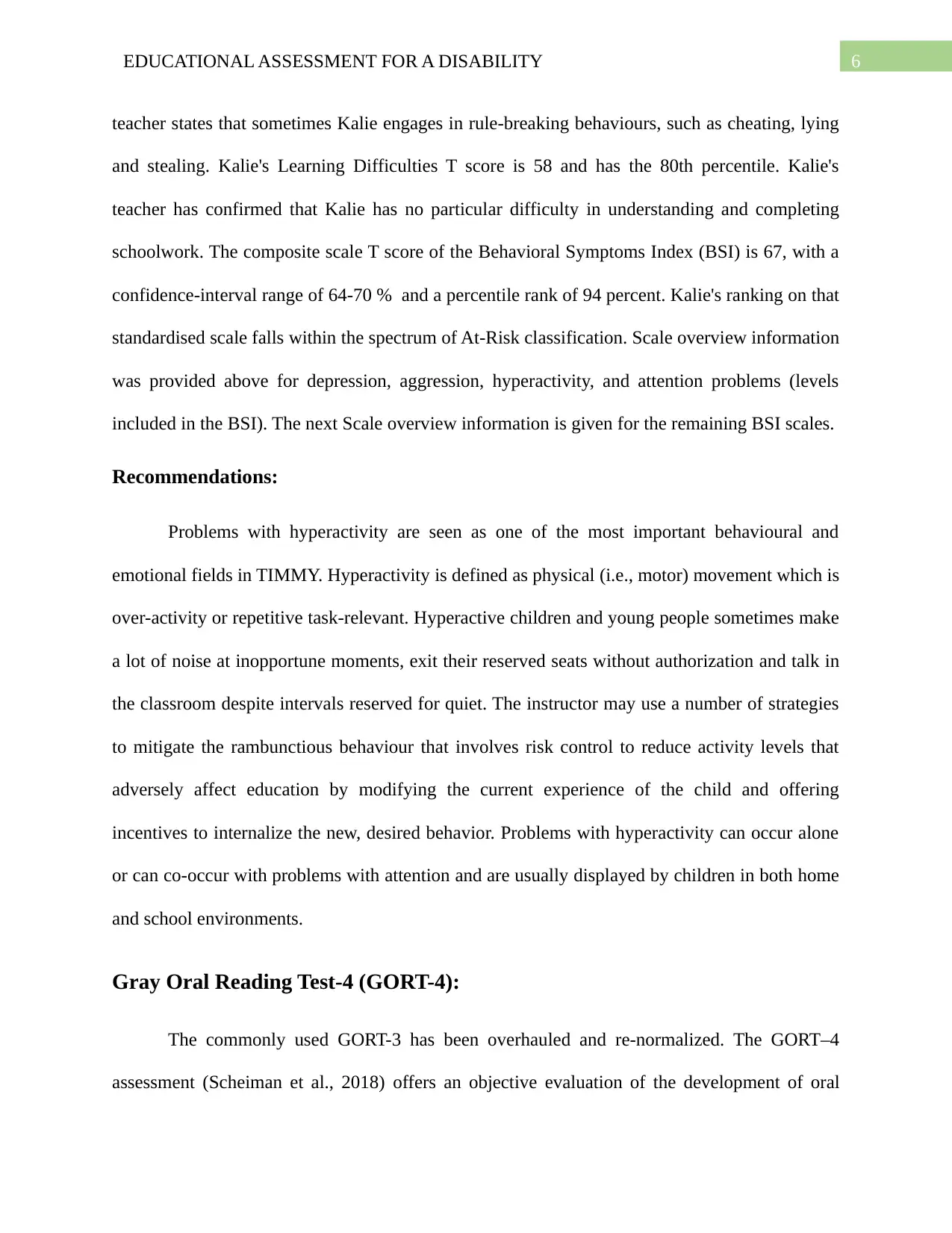
6EDUCATIONAL ASSESSMENT FOR A DISABILITY
teacher states that sometimes Kalie engages in rule-breaking behaviours, such as cheating, lying
and stealing. Kalie's Learning Difficulties T score is 58 and has the 80th percentile. Kalie's
teacher has confirmed that Kalie has no particular difficulty in understanding and completing
schoolwork. The composite scale T score of the Behavioral Symptoms Index (BSI) is 67, with a
confidence-interval range of 64-70 % and a percentile rank of 94 percent. Kalie's ranking on that
standardised scale falls within the spectrum of At-Risk classification. Scale overview information
was provided above for depression, aggression, hyperactivity, and attention problems (levels
included in the BSI). The next Scale overview information is given for the remaining BSI scales.
Recommendations:
Problems with hyperactivity are seen as one of the most important behavioural and
emotional fields in TIMMY. Hyperactivity is defined as physical (i.e., motor) movement which is
over-activity or repetitive task-relevant. Hyperactive children and young people sometimes make
a lot of noise at inopportune moments, exit their reserved seats without authorization and talk in
the classroom despite intervals reserved for quiet. The instructor may use a number of strategies
to mitigate the rambunctious behaviour that involves risk control to reduce activity levels that
adversely affect education by modifying the current experience of the child and offering
incentives to internalize the new, desired behavior. Problems with hyperactivity can occur alone
or can co-occur with problems with attention and are usually displayed by children in both home
and school environments.
Gray Oral Reading Test-4 (GORT-4):
The commonly used GORT-3 has been overhauled and re-normalized. The GORT–4
assessment (Scheiman et al., 2018) offers an objective evaluation of the development of oral
teacher states that sometimes Kalie engages in rule-breaking behaviours, such as cheating, lying
and stealing. Kalie's Learning Difficulties T score is 58 and has the 80th percentile. Kalie's
teacher has confirmed that Kalie has no particular difficulty in understanding and completing
schoolwork. The composite scale T score of the Behavioral Symptoms Index (BSI) is 67, with a
confidence-interval range of 64-70 % and a percentile rank of 94 percent. Kalie's ranking on that
standardised scale falls within the spectrum of At-Risk classification. Scale overview information
was provided above for depression, aggression, hyperactivity, and attention problems (levels
included in the BSI). The next Scale overview information is given for the remaining BSI scales.
Recommendations:
Problems with hyperactivity are seen as one of the most important behavioural and
emotional fields in TIMMY. Hyperactivity is defined as physical (i.e., motor) movement which is
over-activity or repetitive task-relevant. Hyperactive children and young people sometimes make
a lot of noise at inopportune moments, exit their reserved seats without authorization and talk in
the classroom despite intervals reserved for quiet. The instructor may use a number of strategies
to mitigate the rambunctious behaviour that involves risk control to reduce activity levels that
adversely affect education by modifying the current experience of the child and offering
incentives to internalize the new, desired behavior. Problems with hyperactivity can occur alone
or can co-occur with problems with attention and are usually displayed by children in both home
and school environments.
Gray Oral Reading Test-4 (GORT-4):
The commonly used GORT-3 has been overhauled and re-normalized. The GORT–4
assessment (Scheiman et al., 2018) offers an objective evaluation of the development of oral
Paraphrase This Document
Need a fresh take? Get an instant paraphrase of this document with our AI Paraphraser
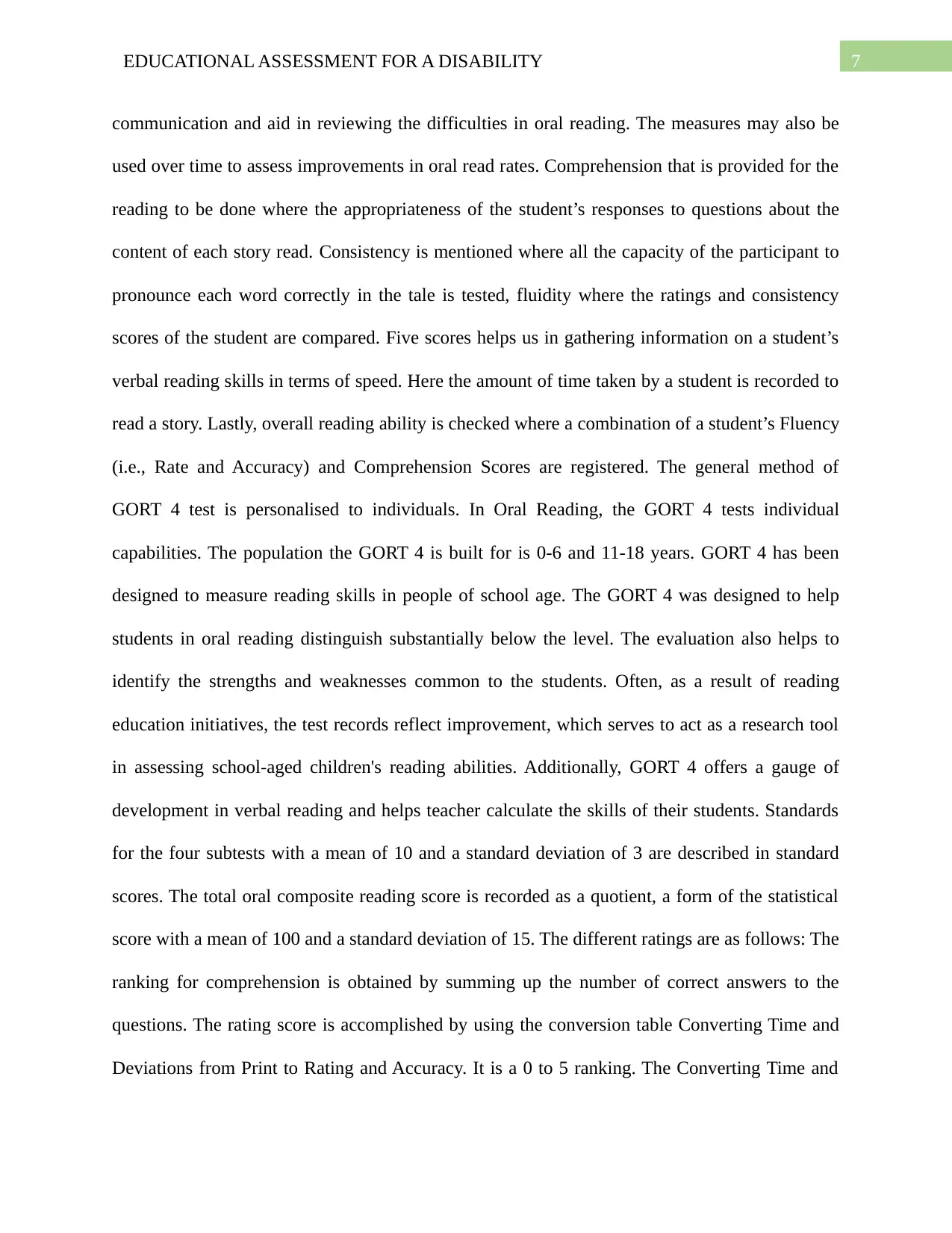
7EDUCATIONAL ASSESSMENT FOR A DISABILITY
communication and aid in reviewing the difficulties in oral reading. The measures may also be
used over time to assess improvements in oral read rates. Comprehension that is provided for the
reading to be done where the appropriateness of the student’s responses to questions about the
content of each story read. Consistency is mentioned where all the capacity of the participant to
pronounce each word correctly in the tale is tested, fluidity where the ratings and consistency
scores of the student are compared. Five scores helps us in gathering information on a student’s
verbal reading skills in terms of speed. Here the amount of time taken by a student is recorded to
read a story. Lastly, overall reading ability is checked where a combination of a student’s Fluency
(i.e., Rate and Accuracy) and Comprehension Scores are registered. The general method of
GORT 4 test is personalised to individuals. In Oral Reading, the GORT 4 tests individual
capabilities. The population the GORT 4 is built for is 0-6 and 11-18 years. GORT 4 has been
designed to measure reading skills in people of school age. The GORT 4 was designed to help
students in oral reading distinguish substantially below the level. The evaluation also helps to
identify the strengths and weaknesses common to the students. Often, as a result of reading
education initiatives, the test records reflect improvement, which serves to act as a research tool
in assessing school-aged children's reading abilities. Additionally, GORT 4 offers a gauge of
development in verbal reading and helps teacher calculate the skills of their students. Standards
for the four subtests with a mean of 10 and a standard deviation of 3 are described in standard
scores. The total oral composite reading score is recorded as a quotient, a form of the statistical
score with a mean of 100 and a standard deviation of 15. The different ratings are as follows: The
ranking for comprehension is obtained by summing up the number of correct answers to the
questions. The rating score is accomplished by using the conversion table Converting Time and
Deviations from Print to Rating and Accuracy. It is a 0 to 5 ranking. The Converting Time and
communication and aid in reviewing the difficulties in oral reading. The measures may also be
used over time to assess improvements in oral read rates. Comprehension that is provided for the
reading to be done where the appropriateness of the student’s responses to questions about the
content of each story read. Consistency is mentioned where all the capacity of the participant to
pronounce each word correctly in the tale is tested, fluidity where the ratings and consistency
scores of the student are compared. Five scores helps us in gathering information on a student’s
verbal reading skills in terms of speed. Here the amount of time taken by a student is recorded to
read a story. Lastly, overall reading ability is checked where a combination of a student’s Fluency
(i.e., Rate and Accuracy) and Comprehension Scores are registered. The general method of
GORT 4 test is personalised to individuals. In Oral Reading, the GORT 4 tests individual
capabilities. The population the GORT 4 is built for is 0-6 and 11-18 years. GORT 4 has been
designed to measure reading skills in people of school age. The GORT 4 was designed to help
students in oral reading distinguish substantially below the level. The evaluation also helps to
identify the strengths and weaknesses common to the students. Often, as a result of reading
education initiatives, the test records reflect improvement, which serves to act as a research tool
in assessing school-aged children's reading abilities. Additionally, GORT 4 offers a gauge of
development in verbal reading and helps teacher calculate the skills of their students. Standards
for the four subtests with a mean of 10 and a standard deviation of 3 are described in standard
scores. The total oral composite reading score is recorded as a quotient, a form of the statistical
score with a mean of 100 and a standard deviation of 15. The different ratings are as follows: The
ranking for comprehension is obtained by summing up the number of correct answers to the
questions. The rating score is accomplished by using the conversion table Converting Time and
Deviations from Print to Rating and Accuracy. It is a 0 to 5 ranking. The Converting Time and
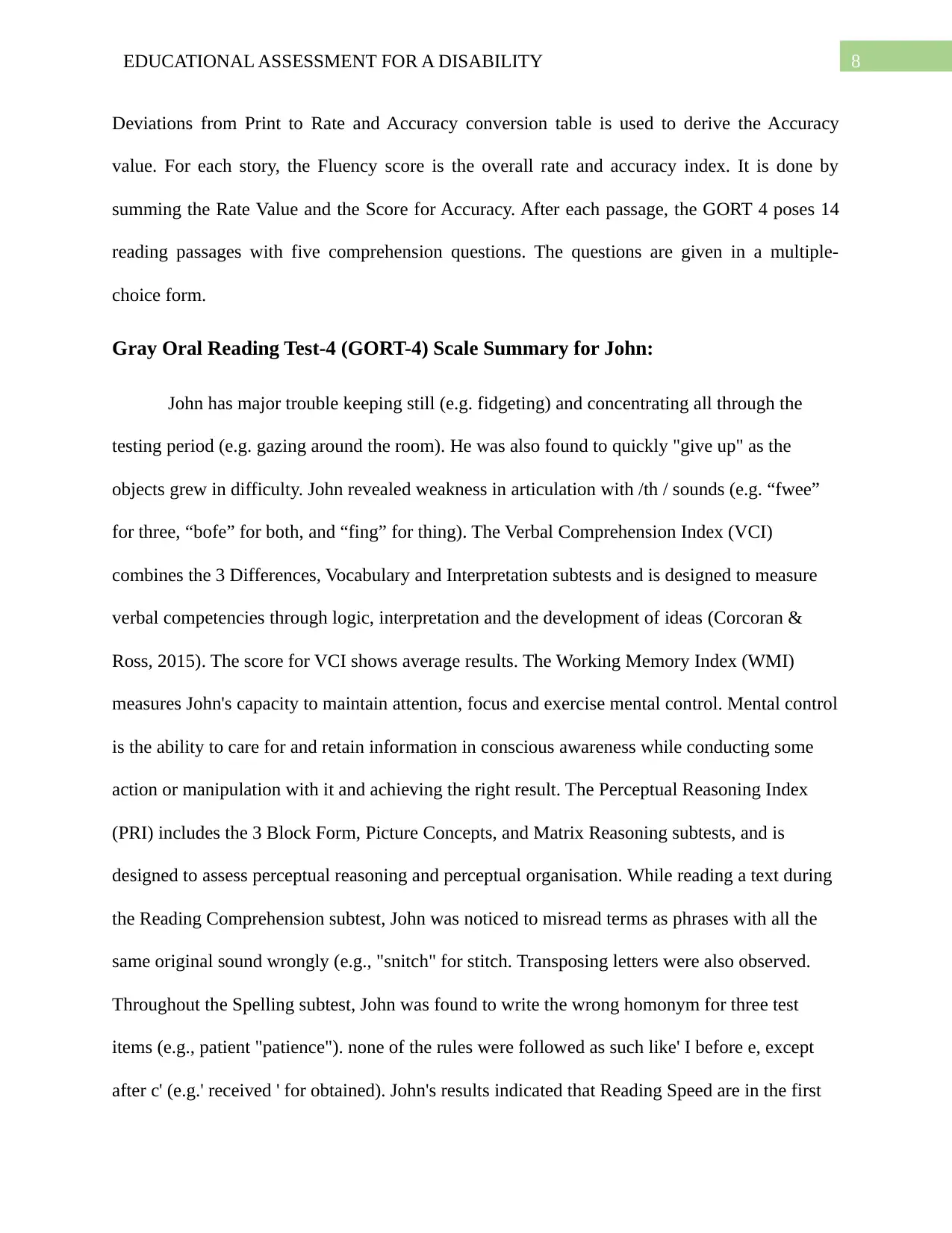
8EDUCATIONAL ASSESSMENT FOR A DISABILITY
Deviations from Print to Rate and Accuracy conversion table is used to derive the Accuracy
value. For each story, the Fluency score is the overall rate and accuracy index. It is done by
summing the Rate Value and the Score for Accuracy. After each passage, the GORT 4 poses 14
reading passages with five comprehension questions. The questions are given in a multiple-
choice form.
Gray Oral Reading Test-4 (GORT-4) Scale Summary for John:
John has major trouble keeping still (e.g. fidgeting) and concentrating all through the
testing period (e.g. gazing around the room). He was also found to quickly "give up" as the
objects grew in difficulty. John revealed weakness in articulation with /th / sounds (e.g. “fwee”
for three, “bofe” for both, and “fing” for thing). The Verbal Comprehension Index (VCI)
combines the 3 Differences, Vocabulary and Interpretation subtests and is designed to measure
verbal competencies through logic, interpretation and the development of ideas (Corcoran &
Ross, 2015). The score for VCI shows average results. The Working Memory Index (WMI)
measures John's capacity to maintain attention, focus and exercise mental control. Mental control
is the ability to care for and retain information in conscious awareness while conducting some
action or manipulation with it and achieving the right result. The Perceptual Reasoning Index
(PRI) includes the 3 Block Form, Picture Concepts, and Matrix Reasoning subtests, and is
designed to assess perceptual reasoning and perceptual organisation. While reading a text during
the Reading Comprehension subtest, John was noticed to misread terms as phrases with all the
same original sound wrongly (e.g., "snitch" for stitch. Transposing letters were also observed.
Throughout the Spelling subtest, John was found to write the wrong homonym for three test
items (e.g., patient "patience"). none of the rules were followed as such like' I before e, except
after c' (e.g.' received ' for obtained). John's results indicated that Reading Speed are in the first
Deviations from Print to Rate and Accuracy conversion table is used to derive the Accuracy
value. For each story, the Fluency score is the overall rate and accuracy index. It is done by
summing the Rate Value and the Score for Accuracy. After each passage, the GORT 4 poses 14
reading passages with five comprehension questions. The questions are given in a multiple-
choice form.
Gray Oral Reading Test-4 (GORT-4) Scale Summary for John:
John has major trouble keeping still (e.g. fidgeting) and concentrating all through the
testing period (e.g. gazing around the room). He was also found to quickly "give up" as the
objects grew in difficulty. John revealed weakness in articulation with /th / sounds (e.g. “fwee”
for three, “bofe” for both, and “fing” for thing). The Verbal Comprehension Index (VCI)
combines the 3 Differences, Vocabulary and Interpretation subtests and is designed to measure
verbal competencies through logic, interpretation and the development of ideas (Corcoran &
Ross, 2015). The score for VCI shows average results. The Working Memory Index (WMI)
measures John's capacity to maintain attention, focus and exercise mental control. Mental control
is the ability to care for and retain information in conscious awareness while conducting some
action or manipulation with it and achieving the right result. The Perceptual Reasoning Index
(PRI) includes the 3 Block Form, Picture Concepts, and Matrix Reasoning subtests, and is
designed to assess perceptual reasoning and perceptual organisation. While reading a text during
the Reading Comprehension subtest, John was noticed to misread terms as phrases with all the
same original sound wrongly (e.g., "snitch" for stitch. Transposing letters were also observed.
Throughout the Spelling subtest, John was found to write the wrong homonym for three test
items (e.g., patient "patience"). none of the rules were followed as such like' I before e, except
after c' (e.g.' received ' for obtained). John's results indicated that Reading Speed are in the first
⊘ This is a preview!⊘
Do you want full access?
Subscribe today to unlock all pages.

Trusted by 1+ million students worldwide
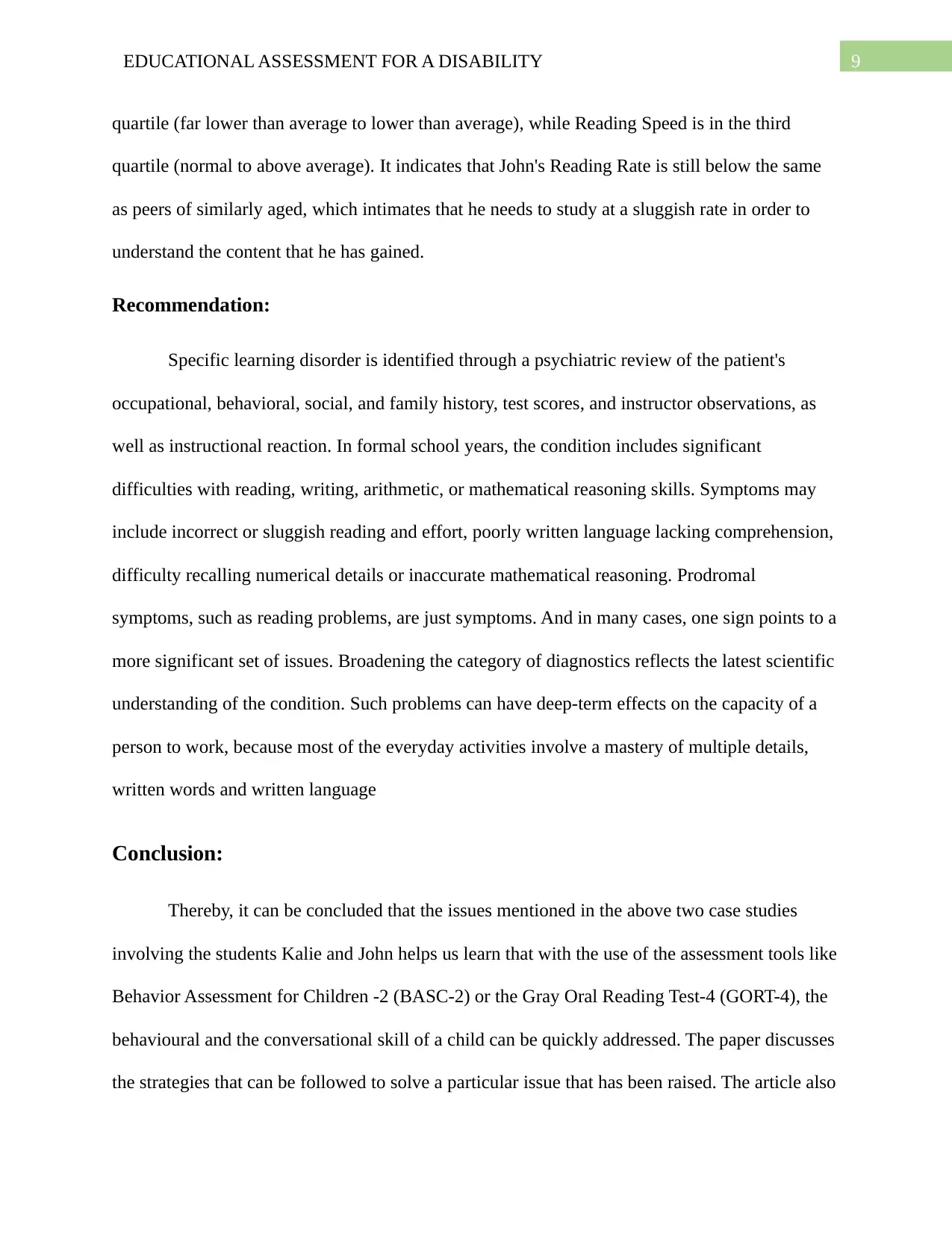
9EDUCATIONAL ASSESSMENT FOR A DISABILITY
quartile (far lower than average to lower than average), while Reading Speed is in the third
quartile (normal to above average). It indicates that John's Reading Rate is still below the same
as peers of similarly aged, which intimates that he needs to study at a sluggish rate in order to
understand the content that he has gained.
Recommendation:
Specific learning disorder is identified through a psychiatric review of the patient's
occupational, behavioral, social, and family history, test scores, and instructor observations, as
well as instructional reaction. In formal school years, the condition includes significant
difficulties with reading, writing, arithmetic, or mathematical reasoning skills. Symptoms may
include incorrect or sluggish reading and effort, poorly written language lacking comprehension,
difficulty recalling numerical details or inaccurate mathematical reasoning. Prodromal
symptoms, such as reading problems, are just symptoms. And in many cases, one sign points to a
more significant set of issues. Broadening the category of diagnostics reflects the latest scientific
understanding of the condition. Such problems can have deep-term effects on the capacity of a
person to work, because most of the everyday activities involve a mastery of multiple details,
written words and written language
Conclusion:
Thereby, it can be concluded that the issues mentioned in the above two case studies
involving the students Kalie and John helps us learn that with the use of the assessment tools like
Behavior Assessment for Children -2 (BASC-2) or the Gray Oral Reading Test-4 (GORT-4), the
behavioural and the conversational skill of a child can be quickly addressed. The paper discusses
the strategies that can be followed to solve a particular issue that has been raised. The article also
quartile (far lower than average to lower than average), while Reading Speed is in the third
quartile (normal to above average). It indicates that John's Reading Rate is still below the same
as peers of similarly aged, which intimates that he needs to study at a sluggish rate in order to
understand the content that he has gained.
Recommendation:
Specific learning disorder is identified through a psychiatric review of the patient's
occupational, behavioral, social, and family history, test scores, and instructor observations, as
well as instructional reaction. In formal school years, the condition includes significant
difficulties with reading, writing, arithmetic, or mathematical reasoning skills. Symptoms may
include incorrect or sluggish reading and effort, poorly written language lacking comprehension,
difficulty recalling numerical details or inaccurate mathematical reasoning. Prodromal
symptoms, such as reading problems, are just symptoms. And in many cases, one sign points to a
more significant set of issues. Broadening the category of diagnostics reflects the latest scientific
understanding of the condition. Such problems can have deep-term effects on the capacity of a
person to work, because most of the everyday activities involve a mastery of multiple details,
written words and written language
Conclusion:
Thereby, it can be concluded that the issues mentioned in the above two case studies
involving the students Kalie and John helps us learn that with the use of the assessment tools like
Behavior Assessment for Children -2 (BASC-2) or the Gray Oral Reading Test-4 (GORT-4), the
behavioural and the conversational skill of a child can be quickly addressed. The paper discusses
the strategies that can be followed to solve a particular issue that has been raised. The article also
Paraphrase This Document
Need a fresh take? Get an instant paraphrase of this document with our AI Paraphraser

10EDUCATIONAL ASSESSMENT FOR A DISABILITY
projects light on the interventions that might help in resolving the problem and help to provide
the child with a better and healthy life ahead.
References:
Kamphaus, R. W., Reynolds, C. R., Hatcher, N. M., & Kim, S. (2014). Treatment planning and
evaluation with the Behavior Assessment System for Children (BASC). The Use of
Psychological Testing for Treatment and Planning and Outcome Assessment, 2, 331-354.
Kamphaus, R. W. (2014). Behavior Assessment System for Children, (BASC‐2). The
Encyclopedia of Clinical Psychology, 1-6.
Scheiman, M., Chase, C., Borsting, E., Mitchell, G. L., Kulp, M. T., Cotter, S. A., & CITT‐RS
Study Group. (2018). Effect of treatment of symptomatic convergence insufficiency on reading
in children: a pilot study. Clinical and Experimental Optometry, 101(4), 585-593.
Corcoran, R. P., & Ross, S. M. (2015). An evaluation of the effectiveness of the Remediation
Plus program on improving reading achievement of students in the Marinette (WI) School
District. Center for Research and Reform in Education.
Bruni, T. P. (2014). Test review: social responsiveness Scale–Second edition (SRS-2).
projects light on the interventions that might help in resolving the problem and help to provide
the child with a better and healthy life ahead.
References:
Kamphaus, R. W., Reynolds, C. R., Hatcher, N. M., & Kim, S. (2014). Treatment planning and
evaluation with the Behavior Assessment System for Children (BASC). The Use of
Psychological Testing for Treatment and Planning and Outcome Assessment, 2, 331-354.
Kamphaus, R. W. (2014). Behavior Assessment System for Children, (BASC‐2). The
Encyclopedia of Clinical Psychology, 1-6.
Scheiman, M., Chase, C., Borsting, E., Mitchell, G. L., Kulp, M. T., Cotter, S. A., & CITT‐RS
Study Group. (2018). Effect of treatment of symptomatic convergence insufficiency on reading
in children: a pilot study. Clinical and Experimental Optometry, 101(4), 585-593.
Corcoran, R. P., & Ross, S. M. (2015). An evaluation of the effectiveness of the Remediation
Plus program on improving reading achievement of students in the Marinette (WI) School
District. Center for Research and Reform in Education.
Bruni, T. P. (2014). Test review: social responsiveness Scale–Second edition (SRS-2).
1 out of 11
Related Documents
Your All-in-One AI-Powered Toolkit for Academic Success.
+13062052269
info@desklib.com
Available 24*7 on WhatsApp / Email
![[object Object]](/_next/static/media/star-bottom.7253800d.svg)
Unlock your academic potential
Copyright © 2020–2025 A2Z Services. All Rights Reserved. Developed and managed by ZUCOL.





